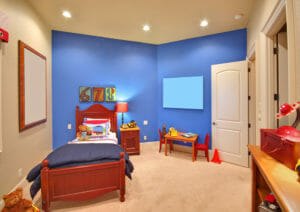
Given these statistics and the curious, busy nature of toddlers, parents and caretakers should take extra precaution to secure their homes and supervise children when playing with toys. Having your child’s friend over for a play date can easily lead to a personal injury claim in the event of an accident. Here are some additional tips to help you create a toddler-proof bedroom.
Tips for Creating a Toddler Proof Bedroom
- Secure furniture.
Furniture is one of the most dangerous parts of any room. If not properly secured, furniture, such as dressers, can fall on top of a child. Children have a tendency to climb on just about anything, but if the large object falls it can cause serious injury or even death. Properly secure furniture with furniture wall straps to help avoid a catastrophe.
- Remove choking hazards.
Toddlers are notorious for putting all sorts of items in their mouths. BabySleepSite.com suggests storing anything that is small enough to fit into a toilet paper roll away and out of the reach of children.
- Secure windows and blinds.
Believe it or not, it’s not uncommon for children to climb out of open windows. If you’re going to leave a window open, or if the window is easy to open, you can secure it with a window stopper device, which is available at baby stores or online at sites like Amazon. Also, don’t forget to secure window blind cords, which can easily become a strangulation danger.
- Take extra steps to protect electrical outlets from toddlers.
As toddlers begin to explore everything and anything, outlet covers may not be enough. Look into alternative safety measures such as a safe plate, which automatically slides over an electrical outlet when not in use.
- Safeguard electrical cords.
It’s natural for kids to want to pull on things during playtime. Make sure that electrical cords are securely fastened or hidden to prevent your child from pulling on a cord that can result in something dangerous falling on them. Even if it seems like no big deal, it’s best to prevent it from being a hazard altogether.
- Big kid bed safety.
When a child transitions to sleeping in a bed, it’s a good idea to install railings to keep them from accidentally falling on the floor. Some parents also like to place cushioning on the floor next to the bed in case the child does fall.
- Be mindful of what you place on shelves.
Even if the shelf is secured, the items on it may not be. Think twice before placing something heavy or something fragile like glass that can break and cause injury to your child on a shelf.
- Use safety gates.
As children grow, especially once they are walking, they will want to explore the house. When kids start getting out of their bed on their own, parents may not know the child is up and walking around. Even with a baby monitor, sometimes parents miss things such as when they’re in the shower. Place a baby gate in areas that you would not want your child to go to should they wander off without supervision.
Because it’s impossible to predict your toddler’s every move, the more precautions you can take around your home, the better. If in the unfortunate event that a child is seriously injured or suffers a fatal accident, the family may be entitled to recover for damages. Speak to a personal injury attorney to learn more.
References:
Johnson, N. (n.d.). 5 Child Proofing Tips for Your Toddler’s Room | The Baby Sleep Site – Baby / Toddler Sleep Consultants. Retrieved January 26, 2017, from http://babysleepsite.com/safety/child-proofing-toddler-sleep/
Safe Kids Worldwide Home Safety Fact Sheet (2015). (n.d.). Retrieved January 26, 2017, from https://safekids.org/sites/default/files/documents/skw_home_fact_sheet_feb_2015.pdf
Toddler-proof the bedroom. (2015, April 6). Retrieved January 26, 2017, from https://babyclub.asda.com/Articles/toddler-proof-the-bedroom
